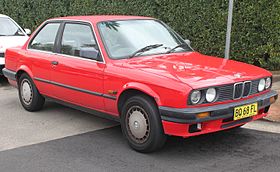BMW 3 Series (E30)
| BMW 3 Series (E30) |
|
|---|---|

1990 BMW 318i (E30) coupe
|
|
| Overview | |
| Manufacturer | BMW |
| Production | 1982–1993 |
| Designer |
Claus Luthe (sedan & coupe: 1978) Max Reisböck (Touring: 1984, 1985) |
| Body and chassis | |
| Class | Entry-level luxury car |
| Body style | 2-door coupe 2-door convertible 4-door compact sedan 5-door Touring |
| Layout |
FR layout (most) F4 layout (325iX) |
| Powertrain | |
| Engine | |
| Dimensions | |
| Length | 1988-89 Sedan & Wagon: 4,450 mm (175 in) 1988-89 Convertible: 4,460 mm (176 in) 1990-91 Sedan & Wagon: 4,326 mm (170 in) 1990-93 Convertible: 4,323 mm (170 in) |
| Width | Sedan & Wagon: 1,646 mm (65 in) Coupe: 1,661 mm (65 in) |
| Height | Sedan & Wagon: 1,379 mm (54 in) Convertible: 1,369 mm (54 in) Coupe: 1,400 mm (55 in) |
| Curb weight | 1,070–1,368 kg (2,359–3,016 lb) |
| Chronology | |
| Predecessor | BMW E21 |
| Successor | BMW E36 |
The BMW E30 is an entry-level luxury car which was produced by BMW from 1982 to 1994. The initial models used the coupe (two-door sedan) body style. Four-door sedan models were introduced in 1983, convertibles were introduced in 1985 and estate ("Touring") models were introduced in 1987. The E36 replaced the E30 coupe models in 1990, with other E30 body styles being phased out of production until the final E30 model, a Touring, was produced in June 1994.
The E30 was the first 3 Series to be available in wagon and four-door sedan body styles. It was also the first 3 Series to offer a diesel engine, and all-wheel drive was introduced to the 3 Series range with the 325iX model.
The E30 platform was the basis for the first BMW M3. This M3 is powered by the high-revving BMW S14 four-cylinder petrol engine, which produced 175 kW (235 hp) in its final European-only iteration.
The E30 3-series was penned by Claus Luthe in 1978, the designer of the NSU Ro 80. Externally, the E30's appearance is very similar to twin headlight versions of its E21 predecessor, however there are various detail changes in styling to the E30.
Major changes over the E21 include interior features and revised suspension (to reduce the oversteer for which the E21 was criticised). As per the E21, a Baur convertible was available.
The primary distinctive feature of the BMW E30 models produced for the North American market in 1984–1987 are the elongated front/rear aluminum bumpers. These bumpers are commonly known as "diving boards."
This update included changes to exterior and interior trim. The 323i model was replaced with the 325i at this time and the diesel-engined 324d was introduced.
A factory convertible entered the model range. However, the Baur remained on sale, alongside the factory convertible. The M3 convertible was only offered for the European market.
At Frankfurt in September 1987, BMW introduced a major update to the E30 (often called "Series 2"). The changes to the lineup were the addition of the Touring (station wagon) variant and removal of the 325e model. The M10 4-cylinder engine was replaced by the M40.
...
Wikipedia
